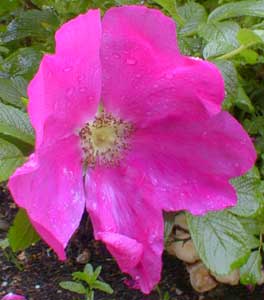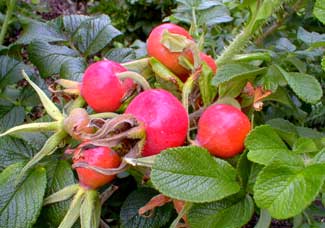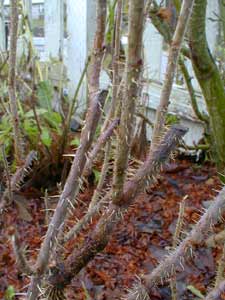
Rugosa Rose; or,
Wild Sea Tomato
"Throw roses on the sea where the dead went down.
The roses speak to the sea,
And the sea to the dead.
Throw roses, O lovers--
Let the leaves wash on the salt in the sun."
-Carl Sandberg
(1878-1967)
(1878-1967)
I've never entirely understood the overriding popularity of hybrid roses. Sure they have nice big sweet smelling flowers that rebloom, but they also have every disease under the sun, need to be pruned & cared for continuously, & rarely make beautiful shrubs per se since they're usually being dressed to maximize the blooms alone.
Ah, but there are exceptions indeed, & Rosa rugosa is everything fancier roses tend never to be. It's a hardy, low-maintanance, beautiful shrub for its crinkly leaves & spiny upright structure, adaptable to almost any soil condition, doing well whether in a moist or dry location, impervious to bad weather.
 And in exchange for causing no problems whatsoever it produces beautiful very fragrant flowers in vast numbers starting no later than late spring & lasting all summer long, with rebloom until the first hard frost. Plus it produces copious numbers of fruits that are sweet & edible.
And in exchange for causing no problems whatsoever it produces beautiful very fragrant flowers in vast numbers starting no later than late spring & lasting all summer long, with rebloom until the first hard frost. Plus it produces copious numbers of fruits that are sweet & edible.Although June is regarded the height of their flowering, ours begin blooming late April or early in May. The photo above is in fact a May Day snapshot. The fruits, or rose hips, ripen in August; later summer blooms will produce hips that are ripening in Autumn.
Its rose hips look like small orange tomatos, as shown in the August fruit photo. They are soft & sweet right off the shrub as soon as they are fully ripened. The last fruits are sweeter still when ripened through a couple frosts in autumn.
They're extremely seedy, however, so a little difficult to appreciate fresh off the branches because difficult to sort the seeds from the pulp. So they're best when used in jams & jellies, sieving the seeds out.
However, if the seeds are eaten, they do have a great deal of Vitamin E, to add to the Vitamin C content of the fruit's flesh. Sieved seeds were traditionally saved, dried, ground up, & mixed with flour to use in baked goods.
Rugosa hips or "sea tomatos" were in a past generation a standard fruit item, especially in coastal communities where orchards of rugosa roses were grown specifically for harvests. They were regarded as one of the finest sweet fruits for autumn. But in our modern age when there are more & more seedless varietes of fruit, & fruits can be shipped quickly even from other countries, the ultra-seedy rugosa hip fell off the list of standard produce items.
Though no longer a standard fruit, the hips are still harvested for commercial uses, including for rose hip teas. The flowers, too, are edible raw or cooked, & the leaves can be used for tea. And for home-canning purposes, they are excellent mixed with any type of fruit or berry to increase the pectin content & their Vitamin C quotient, or mixed with bitter types of autumn berries, crabapples, or green apples, to increase their sweetness.
This native of northern China, Korea, & Japan does have many cultivars with varying growth habits, but we have two that are the species shrub itself, with strongly upright growth habit to about six feet. This very shrub was first introduced in America, into New England, in 1845. Old orchards have since those days gone wild & naturalized in coastal regions.
 Even here in the Northwest, not far from our home there is a lighthouse park along Puget Sound, with an extensive "rugosa rose orchard" that once provided marketed fruit, but has now been let to go completely wild as part of the park. That seaside rugosa orchard recalls those earlier times when Sea Tomatos were a profitable fruitcrop, & one of the few such crops that would thrive even on salt-sprayed sandy ground.
Even here in the Northwest, not far from our home there is a lighthouse park along Puget Sound, with an extensive "rugosa rose orchard" that once provided marketed fruit, but has now been let to go completely wild as part of the park. That seaside rugosa orchard recalls those earlier times when Sea Tomatos were a profitable fruitcrop, & one of the few such crops that would thrive even on salt-sprayed sandy ground.If there is any drawback to growing rugosas, it is the intense spikiness of the limbs. It cannot be planted anywhere near where one wishes to walk safely! But it makes a stunning protective hedge, or anti-burgler shrub around windows. Ours are planted out by the roadside, buffered from the sidewalk by borders of sunroses & lavenders & suchlike.
 The name "rugosa" refers to the wrinkly leaves, which are glossy & attractive in their own right, so that the shrub in or out of flower is really quite attractive. The densely spined upright limbs have a stark glory in winter. If the hips are not harvested in autumn, they linger among the leafless branches long into winter.
The name "rugosa" refers to the wrinkly leaves, which are glossy & attractive in their own right, so that the shrub in or out of flower is really quite attractive. The densely spined upright limbs have a stark glory in winter. If the hips are not harvested in autumn, they linger among the leafless branches long into winter.And what a lot of common names this wild rose has. It is known as Saltspray Rose, Sand Rose, Beach Tomato, or Sea Tomato, for it is preferentially a coastal plant & likes severe maritime conditions. It is the Rugosa Rose, or Wrinkled Rose, Shrub Rose, for its dense foliage, or Hedgehog Rose for the density of its thorns, as shown in the January thorn portrait.
Care of rugosas is a cinch. They do not require fertilization to bloom & fruit well. They want full sun, though they are tolerant of a little shade if need be. The most that needs to be done for their maximum beauty is an annual pruning, in late winter before spring growth begins. The oldest canes should be cut out of the shrub, right down to the ground.
Suckers are easily removed when still young, if an increasingly wide shrub isn't desirable. Suckers can be potted & given away as gifts once they're well rooted. If the suckers are gotten soon enough as stubby shoots devoid of pricklies, they can be cooked in soups.
See also:
Rosa rugosa 'Magnifica'
& see:
Rosa rugosa var alba
Rosa rugosa 'Magnifica'
& see:
Rosa rugosa var alba